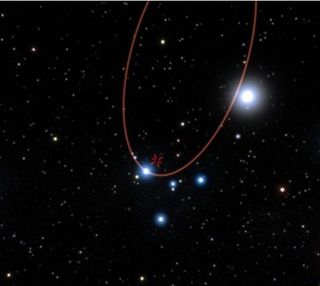Black Hole Imager Gets First View of Galactic Core

A powerful new instrument at one of the world's most powerful observatories is now online and capturing its first deep views of the environment surrounding the black hole behemoth center of our Milky Way.
RELATED: The Race to See Our Supermassive Black Hole
The GRAVITY instrument is currently undergoing commissioning at the Very Large Telescope (VLT) Interferometer at the ESO's Paranal Observatory in Chile and it's prime mission is to ultimately probe the region immediately surrounding Sagittarius A*, the 4 million solar mass supermassive black hole that lurks in the center of our galaxy, around 25,000 light-years from Earth. This sophisticated instrument collects light from the four main 8.2 meter diameter telescopes of the VLT Interferometer, combining it as one.
WATCH VIDEO: How Interferometry Works: GRAVITY and the Event Horizon Telescope
Interferometry allows several different telescopes to act as one large telescope, with the distance between them (their baseline) acting as the diameter of a much larger, virtual telescope. For the VLT, the interferometer mimics a 130 meter-wide telescope, boosting its collecting power 15 times that of a single operating VLT telescope. And now, with GRAVITY online, astronomers hope to probe the strongest gravity environment known in the universe: the very edge of a black hole's event horizon.
RELATED: 'Belt Of Venus' Glows Over Paranal Observatory
Although the instrument has only just gone online, it's already doing some cutting-edge observations of the stars surrounding Sagittarius A*. Of particular interest is a star named S2, which has an extreme 16 year orbit around the black hole. The star's orbit is also highly elongated, bringing it in very close proximity to the massive object. This makes S2 a prime target for studying the conditions of spacetime close to a black hole.
Get the Space.com Newsletter
Breaking space news, the latest updates on rocket launches, skywatching events and more!

S2's orbit is the epitome of extreme. In 2018, the star will reach the closest part of its 16 year journey around Sagittarius A*, coming as close as 17 light-hours of the black hole's event horizon. At this point, the star will be traveling 30 million kilometers per hour, that's 2.5 percent the speed of light! This makes S2 the perfect tracer for astronomers using GRAVITY to measure its position to extreme precision to check whether its motion agrees with predictions set out by Einstein's general relativity.
RELATED: Wormholes Might Burrow Through Black Hole Cores
"It was a fantastic moment for the whole team when the light from the star interfered for the first time -- after eight years of hard work," said Frank Eisenhauer, GRAVITY's lead scientist from the Max Planck Institute for Extraterrestrial Physics in Garching, Germany. "First we actively stabilized the interference on a bright nearby star, and then only a few minutes later we could really see the interference from the faint star -- to a lot of high-fives."
But GRAVITY's mission has only just begun. It will continue to study Sagittarius A*, eventually detecting and tracking flaring events near the event horizon, in real time, to measure the physics of the most extreme, strong gravity environment known.
GRAVITY isn't the only project in pursuit of getting up-close and personal with the supermassive black hole lurking in our galaxy's core. The Event Horizon Telescope, an interferometer composed of several radio telescopes around the globe, is also nearing completion and the first historic images of Sagittarius A*'s event horizon halo are only months away.
Source: ESO
Originally published on Discovery News.
Join our Space Forums to keep talking space on the latest missions, night sky and more! And if you have a news tip, correction or comment, let us know at: community@space.com.
Ian O'Neill is a media relations specialist at NASA's Jet Propulsion Laboratory (JPL) in Southern California. Prior to joining JPL, he served as editor for the Astronomical Society of the Pacific‘s Mercury magazine and Mercury Online and contributed articles to a number of other publications, including Space.com, Space.com, Live Science, HISTORY.com, Scientific American. Ian holds a Ph.D in solar physics and a master's degree in planetary and space physics.
